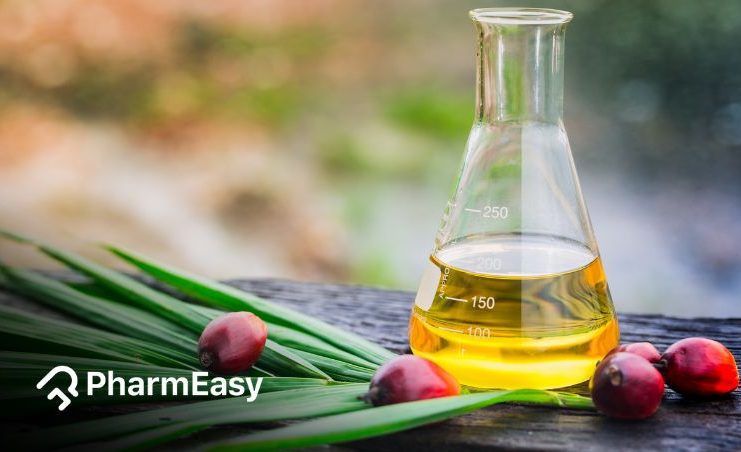Is Palm Oil Bad for You?
By Dr. Malavika Athavale +2 more

Get,

to manage your symptom
Get your,


4 Cr+ families
benefitted

OTP sent to 9988776655



You’ve successfully subscribed to receive
doctor-approved tips on
Whatsapp

Get ready to feel your best.

Hi There,
Download the PharmEasy App now!!


Register to Avail the Offer
Send OTPBy continuing, you agree with our Privacy Policy and Terms and Conditions

Hi There,
Sign up on PharmEasy now!!
Trusted by 4 crore+ families

OTP sent to 9988776655



You have unlocked 25% off on medicines




Code: NU25
By Dr. Malavika Athavale +2 more
Table of Contents
Palm oil is a widely used ingredient found in many everyday products, from food items to household goods. Despite its prevalence, there is often limited awareness about what palm oil is and how it is used.
Derived from the fruit of the oil palm tree, palm oil has become a common component in both edible and non-edible products due to its versatility, long shelf life, and cost-effectiveness. It is used in cooking oils, baked goods, snacks, margarine, cosmetics, soaps, and even cleaning products1.

This article explores the origins of palm oil, its various applications, and its nutritional profile. It also considers the ongoing discussions surrounding its impact on health and the environment. Comparisons with other types of oils will be included to help provide a balanced perspective.
Palm oil is an edible vegetable oil extracted from the fruit of the oil palm tree (Elaeis guineensis). Originally cultivated in the western and southwestern regions of Africa, the oil palm is now grown extensively across tropical regions, particularly in Southeast Asia. Due to its unique fat composition, palm oil has become a key ingredient in a wide variety of products worldwide1.
Palm oil production begins with the harvesting of oil palm fruits. The fruits are then steamed or boiled and mechanically pressed to extract the oil. It’s important to differentiate between palm oil and palm kernel oil, though both are derived from the Elaeis guineensis plant, palm oil comes from the fruit’s fleshy pulp, while palm kernel oil is obtained from the seed inside the fruit. Each oil has a distinct composition and is used in different culinary and industrial applications2.
Crude palm oil has a has a distinctive reddish-orange colour, primarily due to its natural carotene content, which is the same pigments that give carrots and tomatoes their vibrant hues. It also contains tocotrienols, a form of vitamin E. These naturally occurring compounds contribute to the oil’s oxidative stability and are part of its overall nutritional profile2.
Palm oil is available in various forms depending on the degree of processing. The two most common types found in consumer products are unrefined and refined palm oil3.
Palm oil has been the subject of considerable attention in discussions surrounding diet and health, largely due to its relatively high saturated fat content. Saturated fats, when consumed in excess, may influence cholesterol levels, which in turn can have implications for heart health. However, palm oil also contains a number of beneficial nutrients, including certain forms of vitamin E and essential fatty acids, which play important roles in supporting overall health.
It is important to consider the type and processing level of palm oil, as these factors can affect its nutritional properties and best use. Below is an overview of commonly available forms of palm oil, their characteristics, and typical applications:
Ever wondered the many ways palm oil is used in our daily life? Let’s take a look.
Palm oil is a common cooking ingredient thanks to its unique taste and adaptability. It’s particularly good for frying because it can withstand high heat.
Palm oil isn’t limited to the kitchen. It is a key ingredient in a variety of everyday non-food items.
Refined and fractionated palm oil is widely utilised in the food industry due to its distinct functional properties. It demonstrates excellent oxidative stability, which allows it to resist spoilage and maintain quality during storage and processing. Furthermore, palm oil contributes nutritional value by supplying essential nutrients that support bodily functions11.
Dr. Siddharth Gupta, B.A.M.S, M.D (Ayu)
Palm oil is a versatile ingredient that plays a significant role in both food and non-food products. Its functional properties and stability have led to widespread use in households and industries around the world.
Unrefined palm oil is a natural source of carotenoids, which the body can convert into vitamin A. This makes it a potentially useful addition to diets where vitamin A deficiency is a concern. Additionally, palm oil contains tocotrienols, a form of vitamin E that has been studied for its antioxidant properties and potential roles in supporting heart and brain function1.
While research into these effects is ongoing, these nutrients are recognised for their contribution to overall health.
Approximately 50% of palm oil’s fat content consists of saturated fats, particularly palmitic acid2. Diets high in saturated fat have been associated with increased levels of low-density lipoprotein (LDL) cholesterol, often referred to as ‘bad’ cholesterol which may raise the risk of cardiovascular disease.
Palm oil, like all oils, is energy-dense and high in calories. Therefore, portion control and overall dietary balance are essential when including it in regular meals.
The nutritional composition per tablespoon of palm oil is as follows4:
While palm oil is often discussed in the context of its saturated fat content, emerging research suggests it may offer certain potential benefits when consumed in moderation as part of a balanced diet. These areas of interest primarily relate to heart and brain health, though further research is necessary to draw firm conclusions.
Some scientific studies have explored the impact of palm oil on heart health, with mixed but noteworthy findings.
Evidence and Research Studies
Considerations
It’s important to emphasise that such findings are associated with moderate consumption within the context of an overall healthy diet. Palm oil is calorie-dense and high in fat, and excessive intake, like that of any fat, may contribute to weight gain and related health issues. Individual dietary needs, existing medical conditions, and overall lifestyle should be considered when evaluating its suitability7.
Research has indicated potential brain health benefits associated with the vitamin E tocotrienols found in palm oil.
Evidence and Research Studies
Studies8 have suggested that tocotrienols in palm oil can help protect the brain against neurodegenerative diseases. These compounds have been linked to a possible slowing of dementia progression and a reduction in the risk of stroke or the development of brain lesions.
Tocotrienols function as antioxidants, which may protect the brain’s delicate polyunsaturated fats from oxidative damage. This protective effect could contribute to slowing the advancement of dementia, lowering stroke risk, and preventing the growth of brain lesions. It is important to note, however, that larger-scale human trials are required to substantiate these preliminary findings.
While palm oil may offer certain health benefits, it has also attracted considerable debate regarding its potential negative effects on both human health and the environment. Understanding these issues is crucial to forming a balanced perspective on palm oil production and consumption.
Much of the health-related discussion around palm oil focuses on its saturated fat content and the possible implications for cardiovascular health.
There is ongoing scientific debate about the relationship between saturated fat intake, blood cholesterol levels, and heart disease risk. Some studies suggest that palm oil does not adversely affect heart health and may even provide certain benefits when consumed in moderation. Conversely, other research indicates that its relatively high saturated fat content could increase levels of low-density lipoprotein (LDL), often referred to as ‘bad’ cholesterol, which is linked to a higher risk of cardiovascular disease2.
The predominant saturated fat in palm oil, palmitic acid, is considered to have a milder effect on blood cholesterol compared to some other saturated fats. Nonetheless, concerns persist that excessive consumption of palm oil could contribute to elevated cholesterol levels and associated health risks2.
The environmental impact of palm oil production is a significant aspect of the wider discussion.
Large-scale palm oil cultivation, particularly in regions such as Southeast Asia, has been associated with substantial deforestation and the destruction of natural habitats. This expansion threatens the survival of endangered species, including the Bornean orangutan and the Sumatran tiger, among others9.
Beyond environmental damage, the industry has faced criticism for labour exploitation and violations of indigenous peoples’ rights, especially in areas where regulatory oversight is limited.
Cheese replacements or imitation products are often preferred for their cost-effectiveness and nutritional profile. When selecting such alternatives, palm oil has demonstrated potential benefits, including a favourable effect on blood cholesterol levels when used instead of milk fat. This is largely attributed to its content of monounsaturated and polyunsaturated fatty acids. Additionally, the natural tocopherol present in palm oil contributes to the nutritional value of cheese analogues. Thus, incorporating palm oil as a source of dietary fat may be a suitable option11.
Dr. Rajeev Singh, BAMS
Also Read: Health Benefits of Coconut Oil for Skin and Hair
Understanding how palm oil compares to other popular oils can provide valuable insight into its role in a balanced diet.
Olive oil is widely recognised for its cardiovascular benefits, primarily because of its high content of monounsaturated fats. Some studies have suggested that palm oil and olive oil may have similar effects on cholesterol levels, despite palm oil’s higher saturated fat content10.
Canola oil contains less saturated fat and more monounsaturated fat than palm oil. It also has a notable proportion of omega-3 fatty acids, which contribute to its reputation as a heart-friendly oil. However, most commercially available canola oil is derived from genetically modified crops, whereas palm oil typically is not10.
Avocado oil is rich in monounsaturated fats and antioxidants, making it one of the healthiest cooking oils available. Similar to palm oil, avocado oil is stable at high temperatures, making both oils suitable for frying and other heat-intensive cooking methods10.
Sunflower oil is known for its high polyunsaturated fat content, especially linoleic acid, which is valued for its potential to lower cholesterol. While its nutritional profile differs from that of palm oil, sunflower oil remains a popular choice for those seeking to manage cholesterol levels10.
Coconut oil, like palm oil, contains a high proportion of saturated fats, particularly lauric acid. Its saturated fat content is generally higher than that of palm oil. Despite this, coconut oil is frequently recommended for its various health effects, although evidence remains mixed and further research is ongoing10.
Also Read: Punarnava: Uses, Benefits, Side Effects & More
Assessing palm oil as either beneficial or harmful is a complex issue that depends largely on consumption patterns, including quantity, frequency, and the context of an individual’s overall diet. While palm oil’s high saturated fat content suggests moderation is necessary, it also provides valuable nutrients such as vitamins A and E, which offers practical benefits in cooking due to its heat stability.
However, the environmental challenges associated with palm oil production are significant and must be taken into account. Therefore, if palm oil is to be included in the diet, it should be consumed judiciously, within a balanced and varied nutritional framework. Choosing palm oil that is sustainably sourced can further help reduce its environmental impact, supporting both personal health and ecological responsibility.
Also Read: How Castor Oil Benefits You And How Much You Need?
The main concern associated with palm oil is its high saturated fat content, which may increase bad cholesterol and heart disease risk. But eating in moderation as part of a balanced diet should not pose major health risks.
Palm oil and olive oil each offer distinct nutritional properties. Olive oil is a source of monounsaturated fats, while palm oil contains natural antioxidants, including vitamin A (as beta-carotene) and vitamin E (tocotrienols and tocopherols). The choice between the two may depend on individual dietary preferences, culinary use, and nutritional considerations.
As with any food, moderation is key. Palm oil contains saturated fats, and the World Health Organization recommends that saturated fat intake should not exceed 10% of total daily calories. When used in small amounts, palm oil can be part of a balanced and varied diet, depending on individual nutritional needs.
There is no conclusive evidence directly linking palm oil consumption to cancer. However, concerns arise from its potential role in a diet high in saturated fats, which may contribute to certain health risks and research on this topic is ongoing.
While palm oil consumption has been associated with elevated levels of LDL cholesterol due to its saturated fat content, the direct link to heart disease remains inconclusive. Moderation in consumption and maintaining a balanced diet are recommended for heart health.
When stored properly in a cool, dark place and sealed tightly, palm oil can have a shelf life of up to a year or more. However, factors such as exposure to heat, light, and air can affect its quality and lead to a shorter storage lifespan.
While rare, some individuals may be allergic to palm oil, experiencing allergic reactions such as skin rashes or gastrointestinal discomfort. However, palm oil allergies are not widespread, and most people can consume it without adverse effects.
Introducing palm oil to babies’ diets is generally not recommended due to its high saturated fat content. Babies need a balanced diet that primarily consists of breast milk or formula, followed by the gradual introduction of age-appropriate solid foods.
Palm oil and palmolein oil are not the same, although both are derived from the palm fruit. Palm oil is in a semi-solid form, while palmolein in the liquid fraction is obtained through a refining process. They have different applications in cooking and food processing.
There is no conclusive evidence that red palm oil directly darkens the skin. While some anecdotal claims suggest potential skin benefits, the impact on skin tone is not well-established, and individual reactions may vary. It’s advisable to consult with a dermatologist for personalised skincare advice.
Disclaimer: The information provided here is for educational/awareness purposes only and is not intended to be a substitute for medical treatment by a healthcare professional and should not be relied upon to diagnose or treat any medical condition. The reader should consult a registered medical practitioner to determine the appropriateness of the information and before consuming any medication. PharmEasy does not provide any guarantee or warranty (express or implied) regarding the accuracy, adequacy, completeness, legality, reliability or usefulness of the information; and disclaims any liability arising thereof.
Comments

Leave your comment...
You may also like
Comments